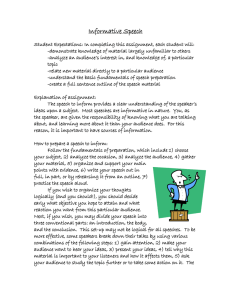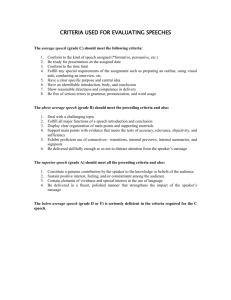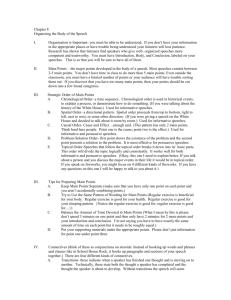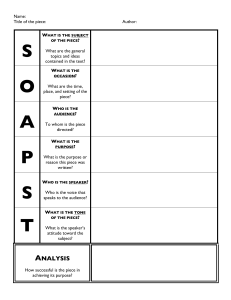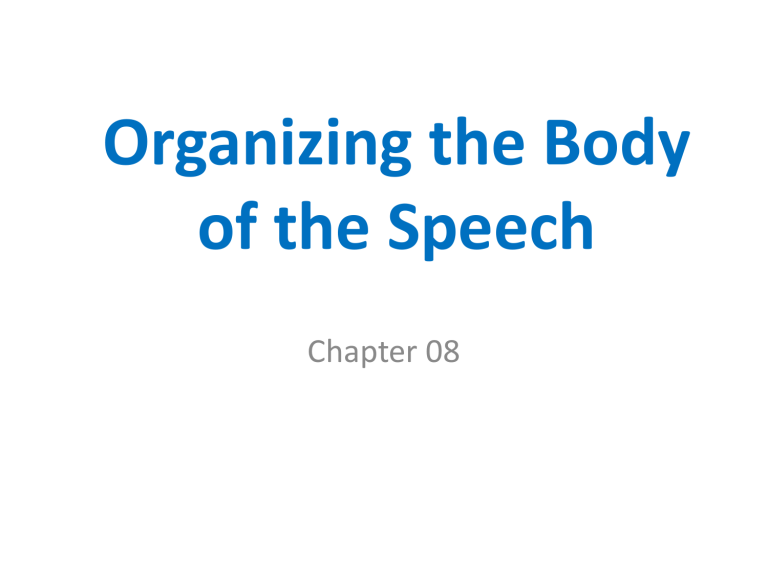
Organizing the Body of the Speech Chapter 08 Organization is Important • It is difficult to pay attention the speaker who ramble aimlessly from one idea to another. • Listeners can’t flip back to the expressed ideas of the speaker and grasp his/her ideas. • Speaker be sure that listeners can follow the ideas in a speech from beginning to the end. • So the ability to organize ideas more effectively for a speech is very important. • Speeches be organized strategically. • A speech should be put together in a particular way to achieve a particular result with a particular audience. • The first step of speech organization is to gain command of the three basic parts of a speech – Introduction – Body – Conclusion • In this chapter we deal with the body of the speech. (longest and most important part) Main Points • The major points developed in the body of a speech. Most speeches contain from two to five main points. • You should select them carefully, phrase them precisely, and arrange them strategically. • Let’s say your specific purpose is “to inform my audience of the basic steps in making glass windows”. Then your main points will be “ steps in the window making process”. Number of Main Points • If you have too many main points, the audience will have trouble sorting them out. • When every thing is equally important. • So try to limit them into two to five. Strategic Order of Main Points • Once you identify your main points, you need to decide in what order you will present them. • It will affect both the clarity and persuasiveness of your ideas. • The most effective order depends on three things – Your topic – Your purpose – Your audience Five Basic Patterns of Organization Chronological Order • A method of speech organization in which the main points follow a time pattern. • They may narrate a series of events in the sequence in which they happened. • Use to explain a process or to demonstrate how to do something. • Especially useful for informative speeches. Spatial Order • A method of speech organization in which the main points follow a directional pattern. • The main points proceed from top to bottom, left to right, front to back, inside to outside or some other route. • Most suitable for informative speeches. Causal Order • A method of speech organization in which the main points show a cause – effect relationship. • According to the topic, you can first deal with causes and then with effects, or first with effects and then with causes. • Used for both persuasive and informative speeches. Problem Solution Order • A method of speech organization in which the first main point deals with the existence of a problem and the second main point presents a solution to the problem. • Most appropriate for persuasive speeches. Topical Order • A method of speech organization in which the main points divide the topic into logical and consistent subtopics. • The main points are simply parts of above four organizational methods. • Because it is applicable to almost any subject and to any kind of speech, topical order is used more than any other method of speech organization. Tips for Preparing Main Points • Keep main points separate. • Try to use the same pattern of wording for main points. • Balance the amount of time devoted to main points. Supporting Materials • The materials used to support a speaker’s ideas. • The three major kinds of supporting materials are examples, statistics and testimony. Connectives • A word or phrase that connects the ideas of a speech and indicates the relationship between them. • Without connectives, a speech is disjointed and dis- coordinated. • Four types of speech connectives are – Transitions – Internal previews – Internal summaries – Signposts • Transitions – a word or phrase that indicates when a speaker has finished one thought and is moving on to another. Let me share, I’ve spoken so far of • Internal previews – a statement in the body of the speech that lets the audience know what the speaker is going to discuss next. It will help listeners to keep track of your ideas. • Internal summaries – a statement in the body of the speech that summarizes the speaker’s preceding point or points. • Signposts – a very brief statement that indicates whether a speaker is in the speech or that focuses attention on key ideas. • Depending on the needs of your speech, you may want to use two, three or four kinds of connectives in combination.
